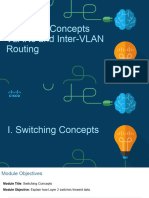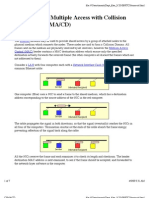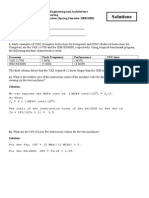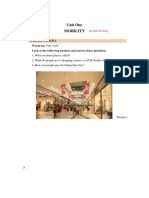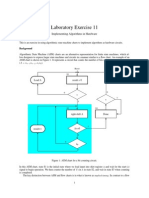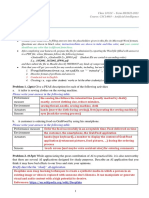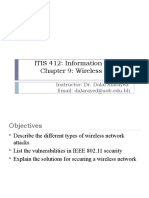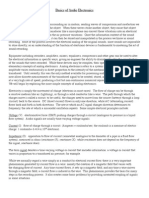Report On CSMA
Report On CSMA
Uploaded by
Utkarsh HathiCopyright:
Available Formats
Report On CSMA
Report On CSMA
Uploaded by
Utkarsh HathiOriginal Title
Copyright
Available Formats
Share this document
Did you find this document useful?
Is this content inappropriate?
Copyright:
Available Formats
Report On CSMA
Report On CSMA
Uploaded by
Utkarsh HathiCopyright:
Available Formats
A Report on CSMA protocols CSMA/CD & CSMA/CA
A Report On CSMA/CD & CSMA/CA
Utkarsh Hathi BTACS 08025
COMP 327 Ms. Pooja Mishra 12th December, 2011
A Report on CSMA protocols CSMA/CD & CSMA/CA
CSMA (Carrier Sense Multiple Access): Carrier Control (MAC) Sense protocol Multiple in Access (CSMA) which a node is a probabilistic Media verifies the Access of
absence
other traffic before transmitting on a shared transmission medium, such as an electrical bus, or a band of the electromagnetic spectrum. "Carrier Sense" describes the fact that a transmitter uses feedback from a receiver that detects a carrier wave before trying to send. That is, it tries to detect the presence of an encoded signal from another station before attempting to transmit. If a carrier is sensed, the station waits for the transmission in progress to finish before initiating its own transmission. "Multiple Access" describes the fact that multiple stations send and receive on the medium. Transmissions by one node are generally received by all other stations using the medium Protocol Modifications: Carrier sense multiple access with collision detection (CSMA/CD) is a modification of CSMA. CSMA/CD is used to improve CSMA performance by terminating transmission as soon as a collision is detected, and reducing the probability of a second collision on retry. Carrier sense multiple access with collision avoidance (CSMA/CA) is a modification of CSMA. Collision avoidance is used to improve the performance of CSMA by attempting to be less "greedy" on the channel. If the channel is sensed busy before transmission then the transmission is deferred for a "random" interval. This reduces the probability of collisions on the channel.
A Report on CSMA protocols CSMA/CD & CSMA/CA
CSMA access modes
1-persistent When the sender (station) is ready to transmit data, it checks if the physical medium is busy. If so, it senses the medium continually until it becomes idle, and then it transmits a piece of data (a frame). In case of a collision, the sender waits for a random period of time and attempts to transmit again. 1-persistent CSMA is used in CSMA/CD systems including Ethernet. P-persistent When the sender is ready to send data, it checks continually if the medium is busy. If the medium becomes idle, the sender transmits a frame with a probability p. If the station chooses not to transmit (the probability of this event is 1-p), the sender waits until the next available time slot and transmits again with the same probability p. This process repeats until the frame is sent or some other sender stops transmitting. In the latter case the sender monitors the channel, and when idle, transmits with a probability p, and so on. p-persistent CSMA is used in CSMA/CA systems including Wi-Fi and other packet radio systems. O-persistent Each station is assigned a transmission order by a supervisor station. When medium goes idle, stations wait for their time slot in accordance with their assigned transmission order. The station assigned to transmit first transmits immediately. The station assigned to transmit second waits one time slot (but by that time the first station has already started transmitting). Stations monitor the medium for transmissions from
A Report on CSMA protocols CSMA/CD & CSMA/CA
other stations and update their assigned order with each detected transmission (i.e. they move one position closer to the front of the queue). O-persistent CSMA is used by CobraNet, LonWorks and the controller area network.
CSMA/CD (Carrier Sense Multiple Access with Collision Detection): CSMA/CD (Carrier Sense Multiple Access with Collision Detection) is the method Ethernet uses to deal with collisions. When a host wants to transmit, it first listens to the wire if anyone else is transmitting at the moment. If its clear, it can transmit; if not, it will wait for the host that is transmitting to stop. Sometimes, two hosts decide at the same instant that the wire is clear, and collide with each other. When this happens, the hosts that were involved with the collision send a special JAM signal that advises everyone on that segment of the collision. Then all the hosts wait for a random period of time before they check the wire and try transmitting again. This wait time is tiny- a few millionths of a second- and is determined y the backoff algorithm. (The backoff algorithm is the mathematical equation a host runs to come with the random number.) The theory is that if each host waits a different amount of time, the wire should be clear for all of them when they decide to transmit again. Any Ethernet segment that uses coaxial cable (10-BASE 2, 10-BASE 5) or a hub with twisted-pair cabling is a collision environment.
A Report on CSMA protocols CSMA/CD & CSMA/CA
Algorithm When a station wants to send some information, it uses the following algorithm: Main procedure 1. Frame ready for transmission. 2. Is medium idle? If not, wait until it becomes ready 3. Start transmitting. 4. Did a collision occur? If so, go to collision detected procedure. 5. Reset retransmission counters and end frame transmission.
Collision detected procedure
1. Continue transmission until minimum packet time is reached to ensure that all receivers detect the collision. 2. Increment retransmission counter. 3. Was the maximum number of transmission attempts reached? If so, abort transmission. 4. Calculate and wait random backoff period based on number of collisions. 5. Re-enter main procedure at stage 1. This can be likened to what happens at a dinner party, where all the guests talk to each other through a common medium (the air). Before speaking, each guest politely waits for the current speaker to finish. If two guests start speaking at the same time, both stop and wait for short, random periods of time (in Ethernet, this time is measured in microseconds). The hope is that by each choosing a random period of time, both guests will not choose the same time to try to speak again, thus avoiding another collision.
A Report on CSMA protocols CSMA/CD & CSMA/CA
Methods for collision detection are media dependent, but on an electrical bus such as 10BASE5 or 10BASE-2, collisions can be detected by comparing transmitted data with received data or by recognizing a higher than normal signal amplitude on the bus.
Figure 1.1:
A Report on CSMA protocols CSMA/CD & CSMA/CA
Jam signal
The jam signal is a signal that carries a 32-bit binary pattern sent by a data station to inform the other stations that they must not transmit. The maximum jam-time is calculated as follows: The maximum allowed diameter of an Ethernet installation is limited to 232 bits. This makes a round-trip-time of 464 bits. As the slot time in Ethernet is 512 bits, the difference between slot time and round-trip-time is 48 bits (6 bytes), which is the maximum "jam-time". This in turn means: A station noting a collision has occurred is sending a 4 to 6 byte long pattern composed of 16 1-0 bit combinations. Note: The size of this jam signal is clearly beyond the minimum allowed frame-size of 64 bytes. The purpose of this is to ensure that any other node which may currently be receiving a frame will receive the jam signal in place of the correct 32-bit MAC CRC, this causes the other receivers to discard the frame due to a CRC error.
Applications CSMA/CD was used in now obsolete shared media Ethernet variants
(10BASE5, 10BASE2) and in the early versions of twisted-pair Ethernet which used repeater hubs. Modern Ethernet networks built with switches and full-duplex connections no longer utilize CSMA/CD though it is still supported for backwards compatibility. IEEE Std 802.3, which defines all Ethernet variants, for historical reasons still bears the title "Carrier sense
A Report on CSMA protocols CSMA/CD & CSMA/CA
multiple access with collision detection (CSMA/CD) access method and physical layer specifications". Variations of the concept are used in radio frequency systems that rely on frequency sharing, including Automatic Packet Reporting System.
CSMA/CA (Carrier Sense Multiple Access with Collision Avoidance): Carrier sense multiple access with collision avoidance (CSMA/CA), in computer networking, is a wireless network multiple access method in which:
A carrier sensing scheme is used. A node wishing to transmit data has to first listen to the channel for a predetermined amount of time to determine whether or not another node is transmitting on the channel within the wireless range. If the channel is sensed "idle," then the node is permitted to begin the transmission process. If the channel is sensed as "busy," the node defers its transmission for a random period of time. Once the transmission process begins, it is still possible for the actual transmission of application data to not occur.
Details The use of collision avoidance is used to improve the performance of CSMA by attempting to divide the wireless channel somewhat equally among all transmitting nodes within the collision domain. CSMA/CA differs from CSMA/CD due to the nature of the medium, the radio frequency spectrum. Collisions cannot be detected while occurring at the sending node,
A Report on CSMA protocols CSMA/CD & CSMA/CA
thus it is vital for CSMA/CA or another access method to be implemented. CSMA/CA is used in 802.11 based wireless LANs and other wired and wireless communication systems. One of the problems of wireless data communications is that it is not possible to listen while sending; therefore collision detection is not possible. Another reason is the hidden terminal problem, whereby a node A, in range of the receiver R, is not in range of the sender S, and therefore cannot know that S is transmitting to R.
IEEE 802.11 RTS/CTS Exchange CSMA/CA can optionally be supplemented by the exchange of a Request to Send (RTS) packet sent by the sender S, and a Clear to Send (CTS) packet sent by the intended receiver R. Thus alerting all nodes within range of the sender, receiver or both, to not transmit for the duration of the main transmission. This is known as the IEEE 802.11 RTS/CTSexchange. Implementation of RTS/CTS helps to solve the hidden node problem that is often found in wireless networking.
A Report on CSMA protocols CSMA/CD & CSMA/CA
Figure 1.2:
10
A Report on CSMA protocols CSMA/CD & CSMA/CA
Performance CSMA/CA performance is based largely upon the modulation technique used to transmit the data between nodes. Studies show that under ideal propagation conditions
(simulations),Direct Sequence Spread Spectrum (DSSS) provides the highest throughput for all nodes on a network when used in conjunction with CSMA/CA and the IEEE 802.11 RTS/CTS exchange under light network load conditions. Frequency Hopping Spread Spectrum (FHSS) follows distantly behind DSSS with regard to throughput with a greater throughput once network load becomes substantially heavy. However, the throughput is generally the same under real world conditions due to radio propagation factors.
11
A Report on CSMA protocols CSMA/CD & CSMA/CA
Bibliography: 1. http://en.wikipedia.org/wiki/Carrier_sense_multiple_access 2. http://en.wikipedia.org/wiki/Carrier_sense_multiple_access_with_collision_avoidance 3. http://en.wikipedia.org/wiki/Carrier_sense_multiple_access_with_collision_detection 4. Ethernet, LAN Technologies, Page no. 17, Michael Valentine & Andrew Whitaker, CCNA, Third Edition (EXAM CRAM)
12
You might also like
- RetoDocument35 pagesRetofranru.parkourNo ratings yet
- Mang May Tin ThiDocument6 pagesMang May Tin ThiHoàng HuyNo ratings yet
- Switching Concepts, VLANs and Inter-VLAN RoutingDocument93 pagesSwitching Concepts, VLANs and Inter-VLAN RoutingMemo LOlNo ratings yet
- Đề chuẩn S1-Openlab-ver16062013Document3 pagesĐề chuẩn S1-Openlab-ver16062013Ngọc Hiếu100% (1)
- UHFPrimeREADER - DLL User Guide V1.0Document43 pagesUHFPrimeREADER - DLL User Guide V1.0Andrian Fathurohman PermanaNo ratings yet
- Ospf Network Analyzing Using OmnetDocument97 pagesOspf Network Analyzing Using OmnetIlaria Curcuglioniti100% (1)
- MVN Studio Real-Time Network Streaming Protocol SpecificationDocument14 pagesMVN Studio Real-Time Network Streaming Protocol SpecificationXsens MVNNo ratings yet
- NovelSat System Performance NovelSat Sys PDFDocument20 pagesNovelSat System Performance NovelSat Sys PDFAndy ChanNo ratings yet
- Nu Horizons March 2011 Edition of PortalDocument32 pagesNu Horizons March 2011 Edition of PortalNu HorizonsNo ratings yet
- Computer Network in UrduDocument25 pagesComputer Network in UrduAbdur Rahman100% (1)
- Carrier Sense Multiple Access With Collision Detection (CSMA/CD)Document7 pagesCarrier Sense Multiple Access With Collision Detection (CSMA/CD)Juicy69MannNo ratings yet
- Opnet CsmacdDocument10 pagesOpnet Csmacddineshs519No ratings yet
- (PDF) Colorless, Directionless and Contentionless Multi-Degree ROADM Architecture For Mesh Optical NDocument25 pages(PDF) Colorless, Directionless and Contentionless Multi-Degree ROADM Architecture For Mesh Optical NBBAdvanz CommunicationsNo ratings yet
- Carrier-Sence Multiprle Access (CSMA) Protocols: Leonidas Georgiadis February 13, 2002Document18 pagesCarrier-Sence Multiprle Access (CSMA) Protocols: Leonidas Georgiadis February 13, 2002pradeep singhNo ratings yet
- Garsia SolutionDocument7 pagesGarsia SolutiongaghanbarianNo ratings yet
- Leach PDFDocument6 pagesLeach PDFNandiniManinarayanaNo ratings yet
- FDI InterfaceDocument4 pagesFDI InterfaceSandip SolankiNo ratings yet
- Thiet Bi Ngoai Vi Va Ki Thuat Ghep NoiDocument28 pagesThiet Bi Ngoai Vi Va Ki Thuat Ghep NoiMạc Hồng TuânNo ratings yet
- BNSG-9000 Firmware User's GuideDocument38 pagesBNSG-9000 Firmware User's GuideBalasundar Ramachandran100% (1)
- Hệ thống nhúng.Document52 pagesHệ thống nhúng.Tuấn NguyễnNo ratings yet
- Presentation On WAPDocument27 pagesPresentation On WAPKayode JohnsonNo ratings yet
- Overview of HSPADocument2 pagesOverview of HSPAmaaouia123No ratings yet
- PfSense FW-7551 Quick Start Guide 7-18-14Document15 pagesPfSense FW-7551 Quick Start Guide 7-18-14dionisionietoNo ratings yet
- Chapter 3 - Problems - Kurose 8Document3 pagesChapter 3 - Problems - Kurose 8Luis Gomes Damasceno Neto UFCNo ratings yet
- Trellis Coded ModulationDocument3 pagesTrellis Coded ModulationAhmed Abdalla HafezNo ratings yet
- Digital Transmission TechniquesDocument85 pagesDigital Transmission TechniquesTafadzwa MurwiraNo ratings yet
- Wireshark Lab TCP16171Document5 pagesWireshark Lab TCP16171Emir UkasyahNo ratings yet
- SoC Encounter TutorialDocument18 pagesSoC Encounter Tutorialsyncc500No ratings yet
- 2.1 LPC2103 Microcontroller: 2.1.1 FeaturesDocument18 pages2.1 LPC2103 Microcontroller: 2.1.1 FeaturesBhaskar Rao PNo ratings yet
- Chapter 8. Mobile Communication Systems PDFDocument70 pagesChapter 8. Mobile Communication Systems PDFPhan Vũ KiệtNo ratings yet
- Final 222 2009 SolDocument6 pagesFinal 222 2009 SolNapsterNo ratings yet
- Lab3 - SDRAM - Modified - 2020Document13 pagesLab3 - SDRAM - Modified - 2020Nguyên Trịnh Vũ ĐăngNo ratings yet
- Spread Spectrum - LabDocument4 pagesSpread Spectrum - LabBibhakar Saha100% (1)
- Computer GraphicsDocument10 pagesComputer GraphicsDeity MeansNo ratings yet
- ASMD Based Design: UART TransmitterDocument19 pagesASMD Based Design: UART Transmittermisss123100% (1)
- UNIT 1nganDocument12 pagesUNIT 1nganthái sơn hoàngNo ratings yet
- Wireshark Lab 3a: The Header Only Contains 4 Fields: The Source Port, Destination Port, Length, and ChecksumDocument4 pagesWireshark Lab 3a: The Header Only Contains 4 Fields: The Source Port, Destination Port, Length, and ChecksumTruonganh BaoNo ratings yet
- Computer Organization and ArchitectureDocument12 pagesComputer Organization and Architecturechand1894No ratings yet
- 2019 03 19 Traffic Analysis Exercise AnswersDocument5 pages2019 03 19 Traffic Analysis Exercise Answershtdquynh270950% (2)
- Sim EKB Install 2020 02 29Document9 pagesSim EKB Install 2020 02 29Jose FiguerasNo ratings yet
- PS2 Keyboard: About The GuideDocument3 pagesPS2 Keyboard: About The GuideLeslie WrightNo ratings yet
- Chinowing V21 User ManualDocument29 pagesChinowing V21 User ManualEvgeniiNo ratings yet
- Final PPT BluetoothDocument17 pagesFinal PPT Bluetoothharivardhanreddy bokkaNo ratings yet
- Tele Traffic LectureDocument18 pagesTele Traffic LectureDramane BonkoungouNo ratings yet
- Nota SAP 2230754Document6 pagesNota SAP 2230754Manuel IbarraNo ratings yet
- Es35 SW BrochureDocument4 pagesEs35 SW BrochureThái Trung TàiNo ratings yet
- Laboratory Exercise 11: Implementing Algorithms in HardwareDocument3 pagesLaboratory Exercise 11: Implementing Algorithms in HardwareTuân PhạmNo ratings yet
- Sentiment Analysis For Vietnamese: Binh Thanh Kieu Son Bao PhamDocument6 pagesSentiment Analysis For Vietnamese: Binh Thanh Kieu Son Bao PhamNguyen LinhNo ratings yet
- 8k Bit Using 6t SramDocument8 pages8k Bit Using 6t SramSwati Navdeep AggarwalNo ratings yet
- 2223 CSC14003 21CLC0607 HW01 SolutionDocument5 pages2223 CSC14003 21CLC0607 HW01 SolutionPhước Sang DươngNo ratings yet
- Kerio Control Adminguide en 9.3.1 3465 PDFDocument352 pagesKerio Control Adminguide en 9.3.1 3465 PDFOsniel BorreroNo ratings yet
- TCP and UDP Performance Comparison in Network On ChipDocument5 pagesTCP and UDP Performance Comparison in Network On ChipJournal of ComputingNo ratings yet
- LAB-4: Network Layer (Packet Tracer Tutorial) : A-Sending Simple Test Messages in Realtime ModeDocument3 pagesLAB-4: Network Layer (Packet Tracer Tutorial) : A-Sending Simple Test Messages in Realtime ModeSendy Trias NugrahaNo ratings yet
- Communications Networks A First Course PDFDocument2 pagesCommunications Networks A First Course PDFMaurice0% (1)
- CCNA 1 Chapter 3 SummaryDocument6 pagesCCNA 1 Chapter 3 SummaryzanarutoNo ratings yet
- TCM ApplicationsDocument50 pagesTCM ApplicationsPhúc Hòa PtitNo ratings yet
- Automating Information Security With Python: Available Training FormatsDocument2 pagesAutomating Information Security With Python: Available Training FormatsSRI HARSHA SARAGADAMNo ratings yet
- Media Access ControlDocument34 pagesMedia Access ControlPrem KumarNo ratings yet
- Media Access ControlDocument34 pagesMedia Access ControlAryan RathoreNo ratings yet
- Csma CDDocument3 pagesCsma CDAashu RajputNo ratings yet
- Unit 3 CNDocument27 pagesUnit 3 CNsiwana2bhishekNo ratings yet
- Lec4 WWW Cs Sjtu Edu CNDocument134 pagesLec4 WWW Cs Sjtu Edu CNAUSTIN ALTONNo ratings yet
- Simrad RS87 морской радио станцияDocument80 pagesSimrad RS87 морской радио станцияVuqar MamedzadeNo ratings yet
- Audio Coding: Ketan Mayer-PatelDocument35 pagesAudio Coding: Ketan Mayer-PatelArial96No ratings yet
- Feedback Amplifiers: Feedback Factor Feedback Signal/input SignalDocument15 pagesFeedback Amplifiers: Feedback Factor Feedback Signal/input Signalshantanu kumar BaralNo ratings yet
- Probecom 3430-L - 4C01 - Manual - 070909Document46 pagesProbecom 3430-L - 4C01 - Manual - 070909abubakrNo ratings yet
- Chapter 9-Wireless Network SecurityDocument58 pagesChapter 9-Wireless Network SecuritymaryaNo ratings yet
- Handover Management IN: WcdmaDocument27 pagesHandover Management IN: WcdmaLalit ThakurNo ratings yet
- Components and System Design For Optical Fiber CommunicationDocument22 pagesComponents and System Design For Optical Fiber CommunicationAnkur ChauhanNo ratings yet
- Module 2 Lesson 4: An Improved Ekf: The Error-State Extended KalmanDocument12 pagesModule 2 Lesson 4: An Improved Ekf: The Error-State Extended KalmanMary JusticeNo ratings yet
- AWP Question Paper 2015Document4 pagesAWP Question Paper 2015Naresh KumarNo ratings yet
- RAN-Evolution 2 Open-RAN Challenges and OpportunitiesDocument6 pagesRAN-Evolution 2 Open-RAN Challenges and OpportunitiesAna Caroline Silveira da PenhaNo ratings yet
- Communication Intelligence COMINTDocument6 pagesCommunication Intelligence COMINTR. RyanNo ratings yet
- ERAN Capacity Monitoring Guide PDFDocument25 pagesERAN Capacity Monitoring Guide PDFDaniel LimaNo ratings yet
- Bss CrossoverDocument36 pagesBss Crossoverian millerNo ratings yet
- Product Specifications: 844G80VTA-SXDocument3 pagesProduct Specifications: 844G80VTA-SXfaapctba2913No ratings yet
- Users Manual 1628629Document24 pagesUsers Manual 1628629Alfredo CarbajalNo ratings yet
- Go EP2SGX130GF1508I4N PDFDocument314 pagesGo EP2SGX130GF1508I4N PDFpkmagendranNo ratings yet
- Model 550 AM/FM Stereo Receiver: Service ManualDocument31 pagesModel 550 AM/FM Stereo Receiver: Service ManualsrinivasanNo ratings yet
- Cable TV DescramblingDocument16 pagesCable TV DescramblingHarold KendalNo ratings yet
- Cable ID: 1A/8A-A.01 (M-B) Test Summary: PASS: Overall ResultsDocument2 pagesCable ID: 1A/8A-A.01 (M-B) Test Summary: PASS: Overall ResultsDarwin LibrandaNo ratings yet
- 3X V65S C3 3XRDocument3 pages3X V65S C3 3XRElego13thNo ratings yet
- Design & Implementation of Real Time Vehicle Theft Monitor, Alert and Control SystemDocument6 pagesDesign & Implementation of Real Time Vehicle Theft Monitor, Alert and Control SystemlambanaveenNo ratings yet
- Basics of Audio ElectronicsDocument8 pagesBasics of Audio ElectronicsPratibhaBhaskarNo ratings yet
- AM Demodulator MC1496Document5 pagesAM Demodulator MC1496John MensahNo ratings yet
- DFT-FFTDocument21 pagesDFT-FFTnahid01757285933No ratings yet
- Radar Systems NotesDocument457 pagesRadar Systems NotesMridula Mittal Bansal100% (2)
- Arbitrary Waveform Data Transfer ProtocolDocument3 pagesArbitrary Waveform Data Transfer ProtocolArief KurniawanNo ratings yet
- Radio Tech Modifications 3 TABASCANDocument168 pagesRadio Tech Modifications 3 TABASCANfrancovellajunior100% (2)


